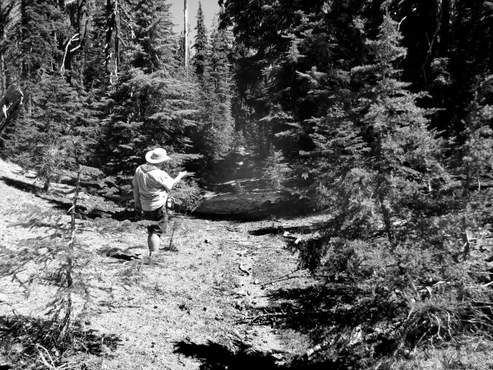The road to Crater Lake
Mail Tribune
Medford, Oregon
July 27, 2008
By BILL MILLER
The U.S. Forest Service is letting the old Crater Lake Wagon Road return to its natural state, but a careful eye can still see the route followed by Peter Britt when he took the first successful photographs of Crater Lake in 1874.
All roads may have led to Rome in the ancient world, but in 19th century Southern Oregon, only one road climbed the rim to Crater Lake.
It may have begun as part of the trail John Wesley Hillman and other prospectors blazed in June 1853 while trying to follow a party of California prospectors that Hillman’s group suspected had rediscovered a lost gold mine.
| If you go… |
| From Medford or Klamath Falls, drive Highway 62 to the west entrance of Crater Lake National Park. About .3 mile, after passing the entrance booth and crossing over Annie Springs Bridge, you’ll see a wide parking area on your right.Here you have two choices. Walk back across the bridge and look for the sign that says Annie Springs Spur Trail. The trail is to the left of Annie Springs. Following this extremely steep trail for .3 mile brings you to a point where you can look across the meadow and through the trees to see some green storage tanks. The flat area in front of the tanks is the old wagon road.An easier look is to continue from the parking area .1 mile past the bridge toward the entrance booth. A maintenance road to your right, once the old Spur Trail and now closed to hiking, is the most obvious view of the old road. |
The rival sourdoughs eventually joined forces and set off looking for landmarks that might lead to the mine.
Perhaps following portions of existing Native American trails, they may have been the first white settlers to discover Crater Lake.
Hillman wrote later that until his mule stopped suddenly right at the rim, he hadn’t been paying attention.
“If I had been riding a blind mule,” he said, “I firmly believe I would have ridden over the edge to death and destruction.”
A few other groups visited the lake over the next few years, but it was James Sutton’s party in 1869 that is credited with blazing the basic trail that would become the Crater Lake Wagon Road and the primary route to Crater Lake for the next 30 years.
The trail branched off from the recently constructed military road between Jacksonville and Fort Klamath. In a narrow meadow, just west of Annie Springs, the trail climbed north for half a mile, then veered northeast until it reached Dutton Creek.
From there it was a steep and rocky climb to the rim. It was described in 1873 by Samuel Clarke, a writer for the Overland Monthly Magazine:
“We zig-zag and wind the mountain-side for two miles, always going steadily upward. “¦ We cross an open stretch, to find ourselves upon the ridge that forms a segment of the wide-circling rim of Crater Lake.”
Besides blazing the first wagon trail, Sutton’s visit included two other notable events.
Accompanying the party was Annie Gaines, whose name would be given to Annie Creek, in honor of her being the first white woman to climb down and touch Crater Lake’s blue waters.
The other event would have been historic had it succeeded. Sutton had borrowed a camera from Jacksonville’s Peter Britt.
“I was prepared to take photographs of the lake,” he said, “but owing to the smoke in the atmosphere I did not succeed.”
In 1874, Peter Britt would travel the wagon road and return home with the first successful photographs of Crater Lake.
A newspaper said he had already tried in 1868, but if any photographs were taken then, they’ve never been found.
With few variations, Sutton’s trail remained the main route to Crater Lake until the 20th century, when the lake was designated a national park. By 1906, a new route, still followed today, was constructed through Munson Valley.
The old wagon road became a trail, its ruts sliding away in decades of melting snow.
Trees, shrubs and grass do their best to reclaim the land. And for the hustling tourist on a one-day journey, it might as well be an ancient road to Rome.
Writer Bill Miller lives in Shady Cove. Reach him at newsmiller@yahoo.com.
Other pages in this section


